Singing in the Eldraine
Last week, I began Throne of Eldraine previews by talking about how the set got its fairy-tale theme. This week, I'm going to focus a little more on the "Camelot" side and talk about how the set was structured and how the mechanics came to be. I also have a few preview cards to show off. Hopefully, that sounds fun.
All Knight Long
If I had to use a metaphor to describe the role of the fairy-tale and Camelot components of Throne of Eldraine, I'd use a cake. The fairy-tale component is the icing. It's colorful and sweet and it does a lot to make the cake exciting to look at and fun to eat. The Camelot portion, though, is the cake itself. It's the majority of the set, and it provides the structure and stability. It's not as exciting, but no one wants a cake made completely of icing. The complement of icing to cake is what makes the overall cake-eating experience so enjoyable.
What this all means is that when the Vision Design team had to figure out what the foundation of the set was going to be, we looked to the Camelot portion. We were following on the heels of an entire year on Ravnica, which meant a higher number of multicolor cards. We like to swing the pendulum, so we were interested in pushing back toward monocolor. Interestingly, the initial thoughts from the Creative team were working in the same direction.
One of the questions we always ask early in design is what role does the color pie play in the set? Magic loves structuring things around the number five as that's the number of colors in the game. It's just a natural breaking point. Eldraine obviously needed to have a court as that's the space we were playing in, but what if we took the court structure and blended it with the color pie. What if instead of one court, Eldraine was a world of five courts? Exploratory design and exploratory worldbuilding each independently drifted in that direction, and when we checked in with one other, it was clear that everyone was on board with five courts, each one centered around a different color.
With the five-court system set up, the Vision Design team's next objective was to figure out what we could do that would both play up the flavor of the courts while also promoting some monocolor play. Our initial solution came about because we were trying to solve multiple problems at once, and they seemed to intersect. Because of Kaladesh, R&D had been looking at how to get more colored artifacts into the game, and our early research into the Eldraine trope space showed us that the set wanted more artifacts than normal. I also wanted to find new ways to push into monocolor play while giving players color flexibility when drafting.
The end result of these problems was a novel solution: alternate mana costs. The idea was that we'd have cards that just had two different mana costs in the upper right-hand corner, and you could decide which one you wanted to use. For monocolor play, we made cards that had two versions, including one with more colored mana symbols, and if you paid that cost, the card got stronger or had an additional ability. For artifacts, we made two costs, one generic mana that was more expensive and one colored cost that was cheaper. For color adjusting, we made spells that had two different costs, each one in a different color. This last group of cards was particularly hard to design because we didn't want the costs being the same, as that was just hybrid, but finding abilities that were stronger in one color than another was tough.
This is what we handed over to Set Design, but the artifacts and color-adjusting cards didn't end up proving to be worth it. The artifacts mostly just got played by people in the color, and the color-adjusting cards were just too hard to design. The Set Design team decided that it was simpler to just make a mechanic rather than have a second mana cost, so they created the mechanic adamant (we had also keyworded it early in vision design, calling it "focus"). Spells with adamant reward you if you spend at least three of the same colored mana when casting the card. With the exception of two generic mana–costed artifact creatures, all the adamant cards are on monocolor spells, and all are themed as being part of the various courts.
In fact, two of my preview cards show off adamant, so why don't I let you see them.
First up is Ardenvale Paladin. Each court has its own Knights (I'll be getting to this theme below), and one common cycle makes use of adamant.
Click here to meet Ardenvale Paladin
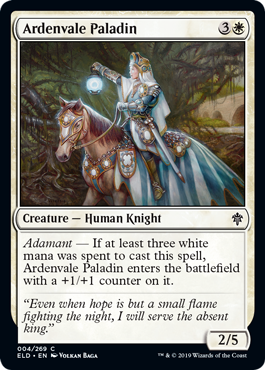
Next is Rally for the Throne. The creative of the card shows off the Circle of Loyalty, another cycle I'll be touching upon below.
Click here to meet Rally for the Throne
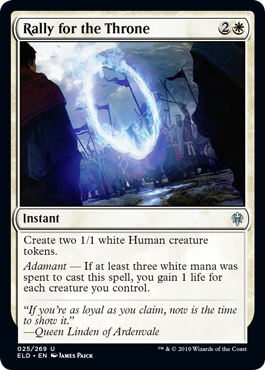
The Creative team spent some time figuring out what each court would be focused on, playing into that color's philosophy. For each court, they came up with a virtue for that court. Note that each virtue played into an already-existing aspect of the color:
- White Court (Ardenvale) – Loyalty
- Blue Court (Vantress) – Knowledge
- Black Court (Lochthwain) – Persistence
- Red Court (Embereth) – Courage
- Green Court (Garenbrig) – Strength
The Vision Design team used those virtues to help flavor each court mechanically. For example, the white court was about loyalty, so we leaned into white's ability to help other creatures. We liked the idea that we could use white's go-wide strategy as a means to show off all its creatures working together. The blue court's virtue was knowledge, so we leaned into its ability to draw and filter cards, and to scry.
The black court's virtue was about persistence, so we played up black's ability to survive fights through things like becoming indestructible and its ability to come back from the graveyard. The red court's virtue was courage, so we leaned into red's aggressive nature and made it more often want to attack. The green court's virtue was strength, so we played up its larger size and its ability to temporarily and permanently buff creatures.
The next thing we did was start making some cycles to play up certain aspects of each court. All the of the following cycles creatively are from the courts, although, a few borrow from some fairy-tale tropes.
Common Adamant Knight Cycle
Ardenvale Paladin above is a member of this cycle. Each is a Knight from the respective court that gets a +1/+1 counter if the adamant cost is paid.
Common Adamant Spell Cycle
These are all instants and sorceries that do basic common effects but have an adamant rider that makes them better if the adamant cost is paid.
Common Colored Equipment Cycle
Crystal Slipper from last week's article is a member of this cycle. This is a cycle of Equipment that have colored mana costs but generic equip costs.
Uncommon Adamant Spell Cycle
Rally for the Throne from above is a member of this cycle. It's similar to the common cycle but with bigger effects and adamant upsides.
Uncommon Legendary Knight Cycle
This cycle is all monocolored legendary Knights. Each mechanically plays into the virtue of the court of its color.
Uncommon Ten-Card Hybrid Cycle
This is a ten-card uncommon cycle (nine creatures and one sorcery) that all have a mana cost of exactly four hybrid mana. These were designed to play well in both monocolor and two-color decks.
Rare Legendary Leader Cycle
This is a rare monocolor cycle of legendary Nobles. It represents the leader of each court. This cycle is designed to have a "color matters" aspect which rewards you for playing lots of cards of that leader's color.
My last preview card is from the legendary leader cycle. Linden is the queen of the white court Ardenvale. She's the stepmother to Rowan and Will. Their father and her husband, King Kenrith, is missing when the story begins.
Click here to meet Linden, the Steadfast Queen
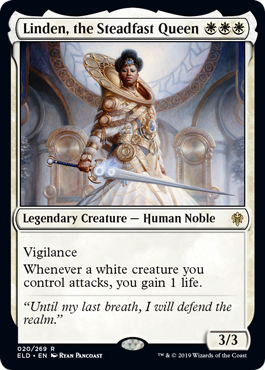
Mythic Rare Legendary Artifact Cycle
This final cycle is monocolored legendary artifacts that represent the most important magical item owned by each court. These mostly play into tropes of Camelot and fairy tales. Like the uncommon legendary Knights, these artifacts play up the mechanical virtues of the color.
You'll Never Know Until You Tribal
We try in every set to have some tribal support as its popular and flavorful. It was apparent from the start that if we were going to play up the courts and the Camelot flavor, the set wanted to have a Knight tribal component. "Salad," what was going to be the second Dominaria set, had played around with Knight tribal, but when it got replaced by Core Set 2019, most of it went away (with a tiny bit trickling into Dominaria). Because of the five courts, every color got a number of Knights, but we ended up putting Knight tribal in just three colors (red, white, and black).
We also wanted to focus on one other tribe, something playing up the fairy-tale creatures. We talked about Faerie tribal, but decided we wanted to be a bit broader than that, so next we explored using batching (last seen on the historic mechanic from Dominaria) to hit a bunch of different creature types all flavored as "fairyfolk." We soon realized, though, that everything we were trying to hit was basically all the creatures that weren't Human, so we experimented with negative tribal support—cards that helped everything but one tribe, in this case, non-Humans. We ended up putting this theme in green, blue, and red.
Also, before I move off of tribal themes, I do want to point out that Throne of Eldraine is introducing three new creature types. The first is Noble, which is showing up in all five colors, and it represents a class for creatures that are rulers or leaders of some kind. The second new creature type is Warlock, and it shows up in this set only in black and represents a class of magic users wielding darker magic. We went back and forth between Witch and Warlock and ended up with Warlock partly because it gets used more often in modern video games and doesn't have as strong of a real-world connection. The third is Mouse, which you all saw last week on Enchanted Carriage. Magic's had Rats since Limited Edition (Alpha), but we felt we couldn't do fairy tales without white mice.
This last mini-theme isn't technically tribal, but it plays in a similar space. With all the magical spells and items in the source material, we liked the idea of a deck that specifically cared about magic. We again explored batching but ended up making cards that care about artifacts and/or enchantments. This theme got put into white and blue.
Some Tales to Tell
While all this was going on, we were also working to find as many top-down designs as we could for the fairy-tale portion of the set. As I explained last week, we leaned into the modular components of fairy tales and designed them so they could interact with one another in fun and flavorful ways. One of the ongoing issues, though, was where we were going to draw the line. There are a lot of different things in fairy tales, and we needed to figure out what made sense for a Magic world.
For example, one of the very first cards designed in the set was Gingerbrute by Peter Lee. (The card has already been revealed, and it was one of the pieces of art I showed off at my San Diego Comic-Con panel.)

Everyone loved the design, but we weren't sure whether an animated cookie was right for the set. We joked that he was at the line. We just weren't sure which side of the line he fell on. Obviously, in the end, he stayed, but there were other things that we chose not to do. Probably the largest category was talking animals. For instance, early design had a Puss in Boots–inspired card. We decided that in this world, we'd let animals have a little more agency than normal (you could ask a duck to fetch you a key, for example), but them talking or acting like a human was over the line.
Also, because this was a top-down set, we spent a lot more time than usual in vision design designing cards intended for the set. Usually, Vision Design makes a card file that acts as a proof of concept, but with top-down sets, we do a lot of work to show how we would execute on things. It was also important to demonstrate our modular design.
Set Sail for Adventure
Interestingly, when we handed off the file to Set Design, we knew we were missing a mechanic. We talked about where the space wanted to be, but we left that work for the Set Design team. The big thing they felt was missing was that there wasn't a lot of in-game choices. There were a bunch of themes that encouraged you toward including certain cards in your deck, but there wasn't a mechanic that was pushing you to make interesting in-game choices.
The team started by trying to come up with a mechanic that would allow your Knights to go off on quests. This exploration actually ended up creating two mechanics, one of which appears in the set and one of which doesn't. I'll start with the mechanic that made the set. (Mark Gottlieb, by the way, has an article going into great detail about Adventure's evolution, so if you're interested, you can go read that after you read this column. I'll be giving the shorter version.)
One of the early ideas was to bring back the mechanic channel. The mechanic appeared on twelve creature cards in Saviors of Kamigawa, and it let you pay mana and discard the cards to create a spell effect. What if channel (or a renamed version) represented the Knight on a quest? Aaron then suggested that they try a channel-like mechanic, but one where you could still cast the creature from exile.
The Set Design team liked that idea and started pursuing it. As the team began designing Adventure cards, Mark Gottlieb realized that they were essentially two-beat stories which worked just as well with the fairy-tale material as they did with the Knights on quest. In fact, when the dust settled, more of the Adventure cards ended up with a fairy-tale flavor.
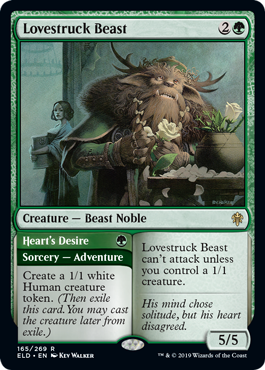
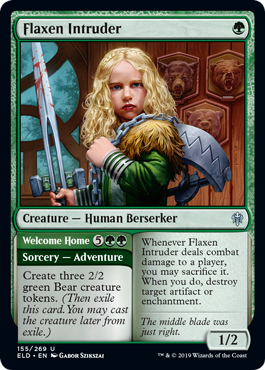
Another side effect of Adventure was that it allowed the ability to take top-down spells and creatures from the same story and combine them on a single card. For example, in vision design, we made a sorcery called Three Bears that created three 2/2 green Bear creature tokens. We had a separate card that represented the little girl. What if those were tied together? This resulted in a lot of very darling cards.
The mechanic that didn't end up getting made was called quest. The way it worked was that it gave you a goal to pursue, and if you did it, you were rewarded with a special mechanically unique token. The mythic rare legendary artifacts were originally structured this way.
Food for Thought
The one other design element that came out of set design was a brand-new artifact token called Food.
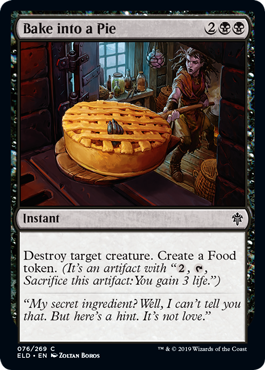
The Set Design team had taken the giant list of tropes we'd created and kept building upon it. One day, someone noticed that a lot of the tropes were about food. Hansel and Gretel used breadcrumbs to find their way and ended up at a gingerbread house. Little Red Riding Hood was taking a basket of food to her grandmother. The fairy godmother turned a pumpkin into a carriage. Jack traded his cow for magical beans. The evil queen tricked Snow White with a poisoned apple. Goldilocks ate the three bears' porridge. The gingerbread man was animated food.
One of the top-down cards Vision Design had created was called Baked into a Pie. The original version was a white Pacifism-like effect that turned the creature into a pie. The pie's owner could sacrifice it to gain 2 life. That card, plus the desire to mechanically reference all the food in the stories, pushed them to making a Food token. Influenced by Clues (from Shadows over Innistrad), they made it an artifact token that could be sacrificed for mana to generate an effect. Life gain was the obvious flavorful choice as gaining life from eating food is a trope woven through all kinds of games. The only thing left to figure out was what did it cost to sacrifice and how much life did you gain? After discussions with Play Design, we then ended up with "2, T: Gain 3 life."
Wrapping Up the Story
And that, in just over 6,000 words from me across two articles, is how Throne of Eldraine got designed. There are a lot of themes to explore as well as a huge amount of modular top-down designs to mix and match. I hope you all have as much fun playing it as we did making it. As always, I'm very eager to hear your thoughts on today's column and Throne of Eldraine in general. You can email me or contact me through any of my social media accounts (Twitter, Tumblr, and Instagram).
Join me next week as I start telling my card-by-card design stories from Throne of Eldraine.
Until then, may your games also end happily ever after.
#671: Banned & Restricted, Part 2
#671: Banned & Restricted, Part 2
This is part two of a four-part series on all the banned or restricted cards I had a hand in designing.
#672: Banned & Restricted, Part 3
#672: Banned & Restricted, Part 3
This is part three of a four-part series on all the banned or restricted cards I had a hand in designing.
- Episode 670 Banned & Restricted, Part 1
- Episode 669 Meet Sarah
- Episode 668 Zones

